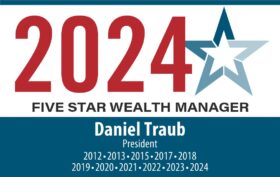(Plus Inflation 101)
The second quarter of 2024 was, well, kind of boring, at least from an investment perspective.
While the S&P 500 was up 4.3% for the quarter, most other areas of the market were down or flat. Small Cap Stocks -3.3%. Foreign stocks -0.4%. Bonds flat.
The average (absolute value) daily price change for the S&P 500 in the second quarter was 0.5%. That is the lowest average daily change for any quarter over the past five years.
Why such low volatility?
The markets are in a holding pattern as we wait for two important outcomes.
The first is the continuing battle over inflation. The classic good (lower inflation, Fed lowers interest rates) versus evil (high inflation, Fed raises rates) story.
Over the past year neither side has been able to declare victory, though I believe it looks promising that good will triumph.
A little side bar on inflation.
Inflation is when prices are higher today than they were yesterday. Economists say that we need some inflation, but not too much. The Fed’s target for inflation is 2% per year.
In 2022 with the pandemic still waning and amidst worldwide supply chain issues, inflation peaked at 9.1%. Since then, it has steadily declined and is currently at 3.3% (which happens to be the long run average from 1914 to 2024!).
Yet, people everywhere are complaining about high prices and seem to believe that if we get inflation under control prices will come back down.
Unfortunately, that is not how it works.
Even if we reach the Fed’s inflation target of 2%, prices are not coming down! The best scenario is that inflation continues to subside, settles at 2% and stays there. Prices will continue to rise, but at a rate considered desirable.
Are prices high? Yes! Is inflation a problem at 3.3%? Hardly!
For there to be lower prices we would need to have deflation, which is much worse for the economy than moderate inflation.
Sidebar over.
The second outcome we await is the presidential election, which increasingly seems to have inflationary implications as well.
I always say that presidents get way too much credit for economic successes and too much blame for economic failures, the majority of which they do not control. (The Fed has a much bigger impact.)
Can we blame Trump for the pandemic? No!
Can we blame Biden for supply chain issues? No!
These are world-wide issues. Other countries had it worse than we did.
Presidents don’t actually have many tools at their disposal to influence inflation, but there are some. Here are a few:
- Reduce Government Spending – That decreases demand in the economy which in turn reduces inflationary pressures. Increased government spending has the opposite effect.
- Stoke Productivity – Investing in infrastructure, education and technology can increase productivity and help curb inflation.
- Encourage Free Trade – Free trade increases the supply of good and services which helps keep prices low. Foreign tariffs are inflationary both by directly increasing prices 2. and reducing the supply of goods.
- Welcome Some Immigration – Increases in the supply of labor moderate wage growth and inflation. This is not to say we should have unfettered immigration. But it does mean that a closed border is inflationary.
Bottom line: Inflation continues to be the sticking point in the markets. I wouldn’t expect much movement either way until the election occurs and the inflationary picture becomes clearer. Waiting is tough!
- Tom Petty
- A common misperception is that foreign companies pay when we tax their goods. In fact, it is the US consumer that pays these tariffs.
Tempo Financial Advisors’ 2nd Quarter Investment Performance
With some segments of the stock market up modestly, some segments of the stock market down modestly and bonds flat, you may not be surprised to hear that Tempo Lifestyle accounts returned from +0.3% to +1% for the quarter. These results were in line with benchmarks.
Year-to-date returns for Lifestyle clients range from +6% to +7.5%, also in line with benchmarks. I’d be ok with these type of boring returns every six months!
Both the Tempo Dynamic Income and Tempo Diversified Income programs were up 0.9% for the second quarter. That is 0.9% better than the BarCap Agg Bond Index, which was flat for the quarter.
Even more impressive are the year-to-date and three-year average annual returns for these programs, especially as compared to the Agg.
Year-to-date the Agg returned -0.7%. For the three years ending 6/30/24 the Agg’s average annual return was -3%. That’s right. On average investors lost 3% a year by investing in the Agg!
Tempo Dynamic Income and Diversified Income returned +4.9% and +3.3% year-to date, and +3.3% and +2.5% on average over the past three years, respectively.
That translates to outperformance over the last three years of about 6% a year. I’ll take it!!!
Reminder
Please contact us if there has been a change in your financial circumstances that would warrant a fresh perspective on your portfolio.
Daniel J. Traub

